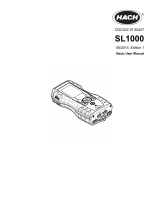
pg | 14
Confirm averaging settings
To quickly check a sonde’s data ltering options, examine
the summary information at the top of either the desktop
or handheld versions of KOR. On the desktop soware, the
word Default, Accelerated, or Rapid will be adjacent to the
sonde’s serial number. Similarly, on the handheld, the letter
D, A, or R will be listed at the top right of the screen.
Adaptive Filtering
e drawback to a basic rolling lter is that response time to an impulse event is delayed, and the more entries
in the average summation, the longer the delay for the result to converge on the true value. To correct this,
the lter algorithm monitors the new data arriving and compares it to the current averaged result, looking
for indication of an impulse event. When new data deviates from the average by more than a predetermined
tolerance, the number of data entries within the rolling average is reduced to a minimum count and the
remaining values are ushed with the new data. e result is a snap to the new value, entirely eliminating
the inherent delay caused by the rolling average.
Outlier Rejection
Every time a newly acquired data value is added, the rolling average entries are scanned for outlier data.
Although such data has already been determined to fall within the tolerances dened above, the remaining
worst oenders are removed from the rolling average calculation. is outlier rejection allows for smoother
continuous data results.
Calibration Stability
During calibration, the ltering is active as described, plus an additional feature works to provide stability
feedback to the user. When the user attempts to calibrate a sensor, the sudden changes in environment are
perceived as impulses or plunge events and the ltering reacts accordingly. e results immediately show the
value of the solution, and aer a few moments, the lter incrementally engages fully and supplies the smoothest
data. However, as the sensor and the calibration solution work towards equilibrium, the measurement may
slowly dri. e sensor will monitor the results from the lter and determine if the measurement is stable. It
watches the results and calculates a slope from each and every result to the next. Once the slope settles and
is consistently at for approximately 30 seconds, the sensor is considered stable. KOR is then notied and
calibration can continue.
Sensor Response Times
Response times for EXO sensors are based on laboratory testing. is testing, though stringent, cannot
mimic the actual response times in the eld due to the wide variety of use cases. To characterize an EXO
sensor’s response time, a step change in the sensor’s primary output parameter is applied, and the time to
reach 63% of the nal stimulus value is recorded. Repeated characterization of multiple sensors provides the
T63 specication.
Sensor Accuracy Specifications
To maintain accuracy specications for EXO sensor, we recommend that users calibrate sensors in the lab in
standards with temperatures as close to the ambient temperature of the eld water as possible.





















